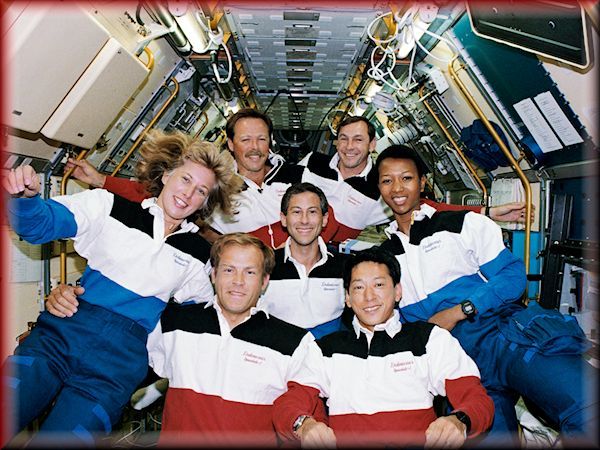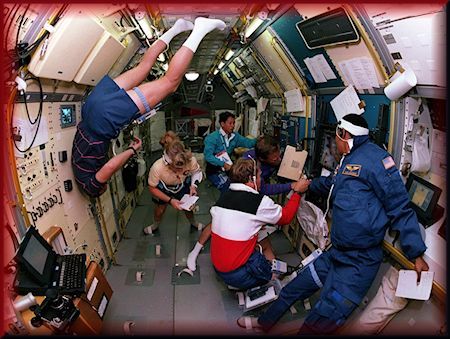
Space Shuttle Endeavour STS-47 had many firsts. The 50th Shuttle flight marks the first NASA mission devoted primarily to Japan. The international crew included the first Japanese astronaut to fly aboard the Shuttle a NASA spacecraft, payload specialist Dr. Mamoru Mohri. Other crew members included the first African-American woman to fly in space, Mae Jemison, and contrary to normal NASA policy, the first married couple to fly on the same space mission, Mark Lee and Jan Davis.
In the top photo the STS-47 crewmembers assemble for their traditional onboard (in-flight) portrait in the Spacelab Japan (SLJ) science module aboard the Earth-orbiting Endeavour, Orbiter Vehicle (OV) 105. Pictured, left to right, back row are Commander Robert L. Gibson and Pilot Curtis L. Brown, Jr; middle row Mission Specialist (MS) N. Jan Davis, MS Jerome Apt, and MS Mae C. Jemison; and front row MS and Payload Commander (PLC) Mark C. Lee and Payload Specialist Mamoru Mohri. Mohri represents Japan's National Space Development Agency (NASDA). The crew was divided into red and blue teams for around the clock operations.
The Mission STS-47 all star crew
Robert "Hoot" Gibson, Commander : Selected by NASA in January 1978, Gibson became an astronaut in August 1979. Gibson has flown five missions and has completed a total of 36-1/2 days in space. He served as pilot on STS-41B (February 3-11, 1984), and was spacecraft commander on STS-61C (January 12-18,1986), STS-27 (December 2-6, 1988), STS-47 (September 12-20, 1992), and STS-71 (June 27 to July 7, 1995). Gibson participated in the investigation of the Space Shuttle Challenger accident, and also participated in the redesign and recertification of the solid rocket boosters. Gibson served as Chief of the Astronaut Office (December 1992 to September 1994) and as Deputy Director, Flight Crew Operations (March-November 1996). Gibson left NASA in November 1996 to pursue private business interests
Curtis L. Brown, Jr, Pilot: Selected as an astronaut candidate by NASA in June 1987, Brown completed a one-year training and evaluation program in August 1988, and is qualified for flight assignment as a pilot. Technical assignments have included: involvement in the upgrade of the Shuttle Mission Simulator (SMS); development of the Flight Data File (FDF); lead of the astronaut launch support team responsible for crew ingress/strap-in prior to launch and crew egress after landing; monitored the refurbishment of OV-102 and OV-103 during ground turnaround processing; lead spacecraft communicator (CAPCOM); Astronaut Office Lead of Shuttle Operations; Deputy Director, Flight Crew Operations Directorate. A veteran of six space flights, Brown has logged over 1,383 hours in space. He was the pilot on STS-47 in 1992, STS-66 in 1994 and STS-77 in 1996, and was spacecraft commander on STS-85 in 1997, STS-95 in 1998, and STS-103 in 1999. Brown retired from NASA to accept a position in the private sector.
Mark C. Lee, Payload Commander: Lee was selected as an astronaut candidate by NASA in May 1984. In June 1985, he completed a one-year training and evaluation program, qualifying him for assignment as a mission specialist on future Space Shuttle flight crews. His technical responsibilities within the Astronaut Office have included extravehicular activity (EVA), the inertial upper stage (IUS), Spacelab and Space Station systems. Lee has also served as a spacecraft communicator (CAPCOM) in the Mission Control Center, as Lead ''Cape Crusader'' at the Kennedy Space Center, Chief of Astronaut Appearances, Chief of the Astronaut Office Mission Development Branch, Chief of the EVA Robotics Branch, and Chief of the EVA Branch. He also worked Space Station assembly issues for the Astronaut Office.
A veteran of four space flights, Lee has traveled over 13 million miles going around the world 517 times and spending 33 days in orbit. Lee retired from NASA and the Air Force effective July 1, 2001.
N. Jan Davis, Mission Specialist: Dr. Davis became an astronaut in June 1987. Her initial technical assignment was in the Astronaut Office Mission Development Branch, where she provided technical support for Shuttle payloads. She then served as a CAPCOM in Mission Control communicating with Shuttle crews for seven missions. After her first space flight, Dr. Davis served as the Astronaut Office representative for the Remote Manipulator System (RMS), with responsibility for RMS operations, training, and payloads. After her second space flight, she served as the Chairperson of the NASA Education Working Group and as Chief for the Payloads Branch, which provided Astronaut Office support for all Shuttle and Space Station payloads. A veteran of three space flights, Dr. Davis has logged over 673 hours in space. She flew as a mission specialist on STS-47 in 1992 and STS-60 in 1994, and was the payload commander on STS-85 in 1997.
After her flight on STS-85, Dr. Davis was assigned to NASA Headquarters as the Director of the Human Exploration and Development of Space (HEDS), Independent Assurance Office for the Office of Safety and Mission Assurance. In July 1999, she transferred to MSFC as Director of the Flight Projects Directorate. In August 2003, she was named Director of Safety and Mission Assurance, with responsibility for the safety, reliability, and quality activities of all MSFC projects and personnel. In October 2005, Dr. Davis retired from NASA.
Jay Apt, Mission Specialist: In 1980 Dr. Apt joined the Earth and Space Sciences Division of NASA’s Jet Propulsion Laboratory (JPL), doing planetary research, studying Venus, Mars, and the outer solar system. In 1981 he became Director of JPL’s Table Mountain Observatory. From 1982 through 1985, he was a flight controller responsible for Shuttle payload operations at NASA’s Johnson Space Center.
He was selected as an astronaut candidate by NASA in June 1985, and qualified as an astronaut in July 1986. Apt flew as a member of the crew of the space Shuttle Atlantis on the STS-37 mission. Dr. Apt was Endeavour’s flight engineer on the crew of STS-47, Spacelab-J. He flew again aboard Endeavour on STS-59, the first flight of the Space Radar Laboratory. Apt served aboard Atlantis during mission STS-79. With the completion of his fourth flight, Dr. Apt has logged over 847 hours (35 days) in space, including 10 hours and 49 minutes on two space walks. He has flown around the Earth 562 times. Dr. Apt left NASA in May 1997.
Mae C. Jemison, Mission Specialist: Dr. Jemison was selected for the astronaut program in June 1987. Her technical assignments since then have included: launch support activities at the Kennedy Space Center in Florida; verification of Shuttle computer software in the Shuttle Avionics Integration Laboratory (SAIL); Science Support Group activities.
Dr. Jemison was the science mission specialist on STS-47 Spacelab-J. Dr. Jemison was a co-investigator on the bone cell research experiment flown on the mission. In completing her first space flight, Dr. Jemison logged 190 hours, 30 minutes, 23 seconds in space. Dr. Jemison left NASA in March 1993.
Mamoru Mohri, Payload Specialist: Selected by the National Space Development Agency of Japan (now referred to as the Japan Aerospace Exploration Agency, JAXA) in 1985, he flew aboard the Space Shuttle Endeavor on the STS-47 (Spacelab-J) mission in 1992. He was the first Japanese astronaut who performed Japan-US joint investigation in space. Dr. Mohri also conducted a "Space Classroom", which was broadcasted live to the children in Japan.
Dr. Mohri was qualified as NASA Mission Specialist (MS) in 1998 and flew for a second time aboard the Space Shuttle Endeavor on the STS-99 mission in 2000. During the mission, he mapped more than 47 million miles of the Earth's surface to develop a 3-D rendition of our planet. Also on the STS-99 mission, for the first time ever, he acquired earth observation data with a High-Definition Television (HDTV) Camera.
Spacelab Payload Spacelab-J was a joint NASA and National Space Development Agency of Japan (NASDA) mission utilizing a manned Spacelab module. The conducted microgravity investigations in materials and life sciences included 24 materials science and 20 life sciences experiments, of which 35 were sponsored by NASDA, 7 by NASA and two collaborative efforts.
Spacelab-J was a joint NASA and National Space Development Agency of Japan (NASDA) mission utilizing a manned Spacelab module. The conducted microgravity investigations in materials and life sciences included 24 materials science and 20 life sciences experiments, of which 35 were sponsored by NASDA, 7 by NASA and two collaborative efforts.
Materials science investigations covered such fields as biotechnology, electronic materials, fluid dynamics and transport phenomena, glasses and ceramics, metals and alloys, and acceleration measurements. Life sciences included experiments on human health, cell separation and biology, developmental biology, animal and human physiology and behavior, space radiation, and biological rhythms. Test subjects included the crew, Japanese koi fish (carp), cultured animal and plant cells, chicken embryos, fruit flies, fungi and plant seeds, and frogs and frog eggs.
Twelve Get Away Special (GAS) canisters (10 with experiments, 2 with ballast) were carried in the payload bay. Middeck experiments were: Israeli Space Agency Investigation About Hornets (ISAIAH), Solid Surface Combustion Experiment (SSCE), Shuttle Amateur Radio Experiment (SAREX II), Air Force Maui Optical Site (AMOS), and Ultraviolet Plume Imager (UVPI).
Spacelab research offers unique opportunities to learn about basic scientific processes and the effects of space travel on humans in preparation for longer stays in space. These opportunities ultimately may lead to useful commercial and medical applications on Earth.
For Spacelab-J, the long module is used. This self-contained 23-foot-laboratory contains a series of equipment racks that hold furnaces, computer and biological workstations, biological incubators, storage lockers and other equipment to perform experiments in space. Additional storage space and experiments are located in the orbiter crew cabin's mid-deck area.
Space Shuttle Era References and resources:
The numbers represent the flight number stating with STS-1, launched on April 12, 1981, STS stands for Space Transportation System. The final landing on July 21, 2011, marked the end of the Space Shuttle Program 30-year run. NASA's space shuttle fleet, Columbia, Challenger, Discovery, Atlantis and Endeavour, flew 135 missions, and helped construct the International Space Station.
The goal of Geek History is to increase awareness, educate, and entertain. We are just trying to get you to think about the many amazing people that have contributed to the world of technology. Our goal in presenting this information on aviation and aerospace history is by no means meant to be any type of authoritative source on the topic. I am not a rocket scientist, nor is space craft or space exploration in my area of expertise, I hope by presenting this information you take the time to learn more.
The biographical information on the astronauts was found on various NASA websites. The photos are from the Internet Archive (Archive.org) as well as NASA websites. The information is believed to be public domain and has been edited and modified to fit the format of GeekHistory.com.
Please refer to the links listed here to find the original photos for your own personal use and learn more on the topics covered.
Astronaut Bios: http://www.jsc.nasa.gov/Bios/
Space Shuttle History: http://www.nasa.gov/externalflash/the_shuttle/
NASA library of images: http://grin.hq.nasa.gov/index.html
NASA Space Shuttle Launch Archive http://science.ksc.nasa.gov/shuttle/missions/missions.html
